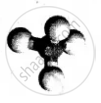Advertisements
Advertisements
Question
Differentiate between the following with suitable examples- A basic radical and an acid radical
Solution
The positive part is called the basic radical and the negative part is called the acid radical.
A compound maybe consider having –
- A positive part [e.g. metal or ammonium ion]
- A negative part [e.g. chloride, bromide, sulphate, nitrate etc.]
| Compound | Positive part - Basic Radical | Negative part - Acid radical |
| Sodium | \[\ce{Na+}\] | \[\ce{NO3-}\] |
| Ammonium | \[\ce{NH4+}\] | `"SO"_4^--` |
| Sulphate |
\[\begin{bmatrix} |
|
|
|
APPEARS IN
RELATED QUESTIONS
Write the names of ZnS compounds :
A liquid compound X of molecular mass 18 u can be obtained from a number of natural sources. All the animals and plants need liquid X for their survival. When an electric current is passed through 200 grams of pure liquid X under suitable conditions, then 178 grams of gas Y and 22 grams of gas Z are produced. Gas Y is produced at the positive electrode whereas gas Z is obtained at the negative electrode. Moreover, gas Y supports combustion whereas gas Z burns itself causing explosions.
- Name (i) liquid X (ii) gas Y, and (iii) gas Z.
- What is the ratio of the mass of element Z to the mass of element Y in the liquid X ?
- Which law of chemical combination is illustrated by this example ?
- Name two sources of liquid X.
- State an important use of Y in our life.
Fill in the following blank with suitable word:
A potassium ion has positive charge because it contains less............... than.....................
An element X has a valency of 2. Write the simplest formula for bromide of the element.
The valencies (or charges) of some of the ions are given below :
Ion Valency Ion Valency (Charge) (Charge)
Sodium ion 1+ Nitrate ion 1–
Copper ion 2+ Sulphide ion 2–
Using this information, write down the formulae of :
- Sodium sulphide
- Copper nitrate
Explain the formation of (i) sodium ion, and (ii) chloride ion, from their respective atoms giving the number of protons and number of electrons in each one of them. What is the reason for positive charge on a sodium ion and a negative charge on a chloride ion ?
Give example.
Trivalent basic radicals
State if the following element or radical is divalent?
Bromide
State if the following element or radical is divalent?
Nitride
State if the following element or radical is divalent?
Dichromate

